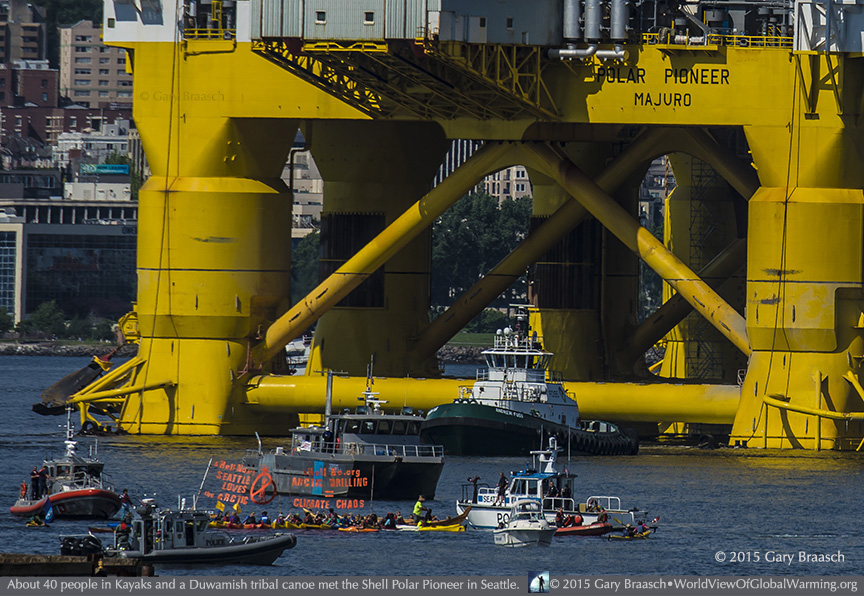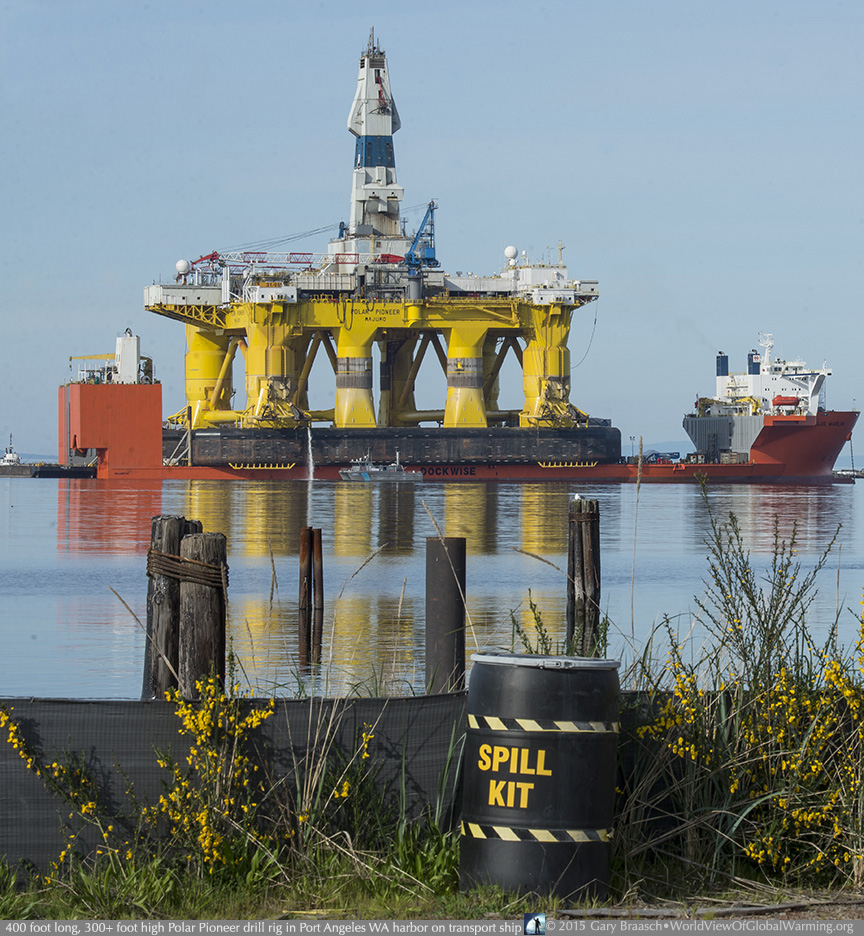Shell drilling rig incites protests in Seattle; Alaska seabirds also at risk by drill plan.
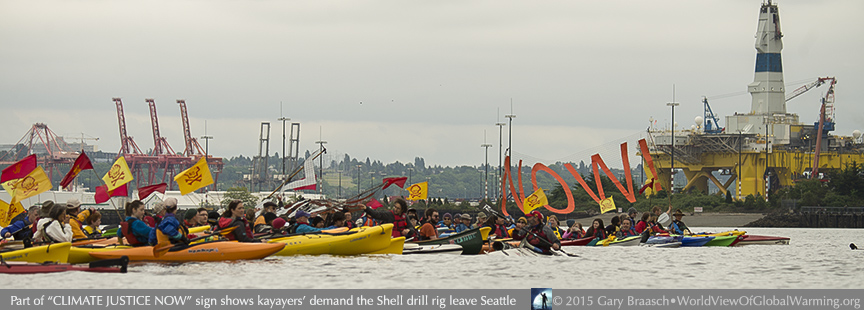
While hundreds of “kayaktivists” paddled into Seattle Harbor May 16 to protest the docking of Shell OIl's huge Arctic drilling rig and its role in climate-damaging fossil fuel, a scientist a few miles away said new data in his 40-year Arctic research showed that seabirds migrate right through the area where Shell wants to drill. The finding that black guillemot seabirds travel west and south from their nest sites near Barrow in fall and early winter, crossing the oil exploration area in the Chukchi Sea, is additional information suggesting the risk the drilling poses to the Arctic ecosystem. Shell has had to apply for permits for “non-lethal” harassment of polar bears, whales and seals, walruses and several threatened seabird species which could be disturbed or injured during oil drilling.
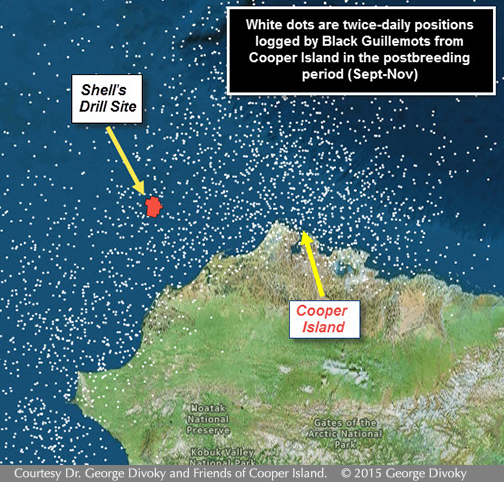
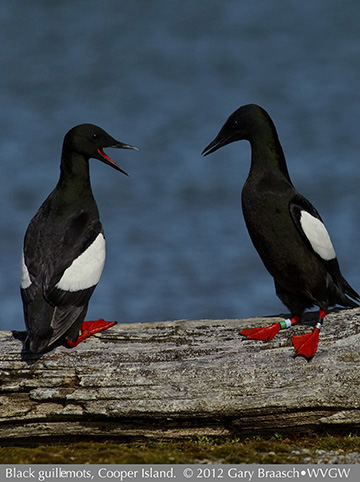
In a blog post May 17, Seattle scientist George Divoky displayed a map generated from location information recorded by geolocators attached to 10 of the 200 black guillemots he studies annually at their rookery on Cooper Island just east of Barrow, Alaska, on the Arctic Ocean. To prey on Arctic cod under the sea ice, which the birds prefer, they congregate where sea ice meets the open water of the Arctic Ocean. During nesting and chick feeding season in summer, the rapid disappearance of Arctic sea ice near the Alaska shore heavily affects breeding success of the guillemots. After fledging and as the birds molt into winter plumage, they appear to “ride the ice edge” as Divoky put it, following the freezing line south through the Chukchi to the Bering Sea. During part of the molt they are unable to fly, making them "extremely vulnerable" to an oil spill, said Divoky.
The bird tracking data show the birds, during October and later until the ice freezes farther south, congregate in the area that Shell Oil has leased for drilling. It had not been known before this where most of the birds spent fall and winter. Shell Oil’s plan, recently conditionally approved by the Interior Department as having “no significant impact," allows drilling from July 1 until October 31. Shell says it will fly helicopters on 40 round trips per week to the drill site 70 miles west of Alaksa, plus daily fixed wing flights from Barrow. In addition to this constant air activity, on and in the water Shell will have two giant floating drill platforms and many service vessels constantly at work. Interior’s environmental report estimated a 75 percent chance of a 1000 barrel (42,000 gallons) or larger oil spill during the life of the drilling project — this in one of the richest wildlife and fish regions of the Arctic, most likely under ice, and far from resources to contain a spill. The drill site is just south of a rich walrus habitat area which has been closed to new drilling by President Obama.
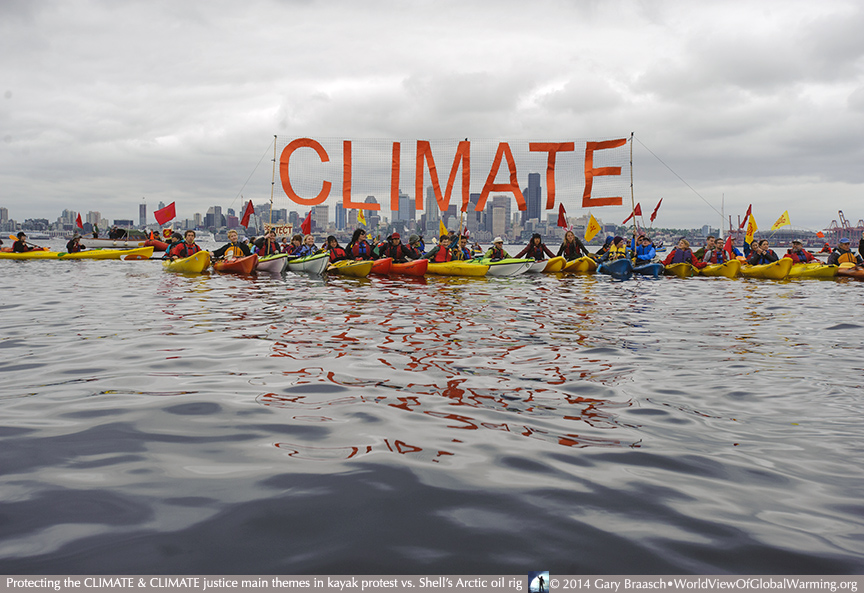
Divoky wrote in his blog that “two hundred guillemots now breed on the island annually, with an additional 50-100 young fledging every year, and the frequency of Cooper Island birds in the drilling area is even higher than shown on the attached map. It appears that in the fall the majority of the population occupies the area where drilling has been proposed.” Divoky has been studying these birds on Cooper Island for more than 40 years, tracking the changes brought on by the loss of Arctic Sea ice — which is more rapid than scientists predicted and will be made worse by CO2 from burning the oil Shell wants to drill.
Protecting the climate and environment was the rallying cry for many hundreds of protesters who took to the harbor from West Seattle beaches in multi-colored kayaks and a few sailboats, skiffs and paddle boards on May 16. Giant banners saying CLIMATE JUSTICE NOW were held aloft by rafted layers, and a sailboat’s rigging proclaimed, “75% chance of an oil spill — WTF?" Three native canoes joined the protest against Shell’s drilling plans and its rig’s hulking presence in the harbor. The 300 foot rig is moored in a dredged Duwamish channel of the river named for the local native tribe, which has been an industrial and superfund site for years. The afternoon-long demonstration followed the smaller protest that greeted the rig Polar Pioneer as it entered the harbor two days before, and came before a major land-based demonstration at the entrance to the dock, terminal 5, on May 18.
Giant Shell Arctic drill rig Polar Pioneer enters Seattle harbor against wishes of city and many citizens
The huge Shell Oil floating rig being prepared to drill in the Arctic Ocean off Alaska this summer, was towed into Seattle Harbor May 14, against the wishes of the City of Seattle and many citizens. A flotilla of “kayaktivists” and a Duwamish tribal canoe paddled out in protest, dwarfed by the 400 foot wide rig that is more than half the height of the 600 foot Space Needle. Coast Guard rules enforced also by Seattle Police boats, kept the about 40 protesters 500 m from the rig, but when the rig stopped moving at one point the protestors were able to raise banners in front of it saying “Arctic Drilling = Climate Chaos,” and "Seattle Loves the Arctic.”
Shell has permits from the Port of Seattle for Foss Maritime Company to make the final preparations of this and another large drill ship at Terminal 5, but the City of Seattle has said this use of the cargo terminal was not allowed and needed additional permits. The Mayor, Ed Murray, said helping to drill for more fossil fuels was not in the City’s interest. The Port of Seattle said it would fight that ruling, but did not rescind the contract with Shell. So the company and Foss proceeded with the 70 mile tow of the Polar Pioneer from Port Angeles. See story below for more information.
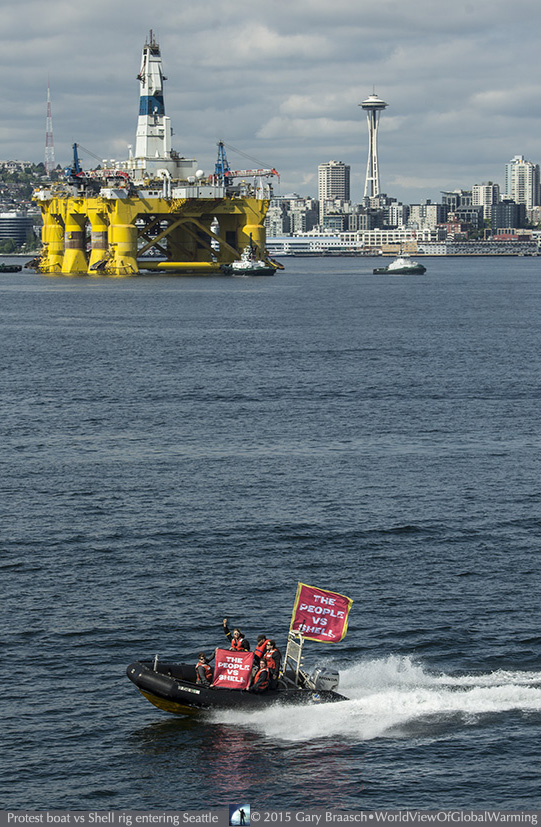
The rig move coincided with other actions which were against fossil fuel development, as the University of Washington regents voted to disinvest in fossil fuel company stock and eight Washington and BC Indian tribes opposed the Gateway Pacific coal export terminal proposed for Cherry Point north of Bellingham, Washington. Protesting groups in Seattle plan a huge kayak paddle demonstration in Seattle Harbor on May 16 in opposition to Shell’s drilling plans, and a protest on the land side of Terminal 5 on May 18.
Giant ocean drill rig, physical manifestation of Shell’s risky bid to resume Arctic oil drilling, arrives in Washington State on 5th anniversary of BP Gulf oil disaster
Five years after the Deepwater Horizon drill rig disaster and oil spill in the Gulf, Shell has brought high-stakes and controversial offshore oil drilling back into public attention with its plan to try again to drill in Arctic waters west of Alaska. In this year during which nations are pledging to cut fossil fuel and other emissions, Shell remains gigantically committed to extracting more petroleum from extreme locations. While the corporation plans to fit out its two giant Arctic oil drilling rigs in Seattle, and is running against strong opposition from environmental and civic groups, it has won approval from the Interior Department for its overall oil exploration plan for Arctic Ocean areas.
For more on Shell, the Mayor and the Port of Seattle, see Joel Connelly’s blog in the Seattle P-I. For details on the Interior Department decision on Shell’s Arctic drill plan, see the NY Times. Also see our earlier posts about Shell’s rig and the anniversary of the Deepwater Horizon BP Gulf oil spill.
15 years of World View of Global Warming, documenting climate change 1999-2015
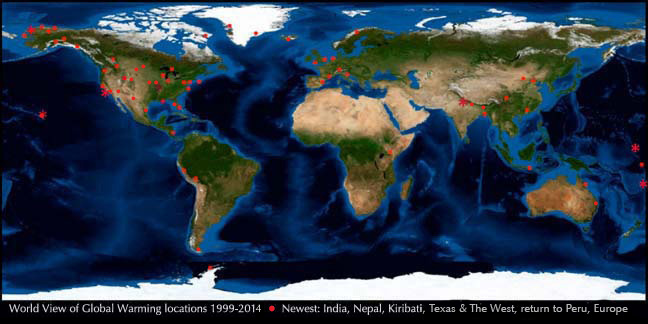
This project would be impossible without scientists and observers around the world who have provided hundreds of scientific contacts and papers. See Background, Advisors, and Reference for documentation, funders and major advisors, without whom I could not complete the work.
World View of Global Warming is a project of the Blue Earth Alliance, Seattle Washington, a 501(c)3 tax-exempt organization. The project is supported entirely by donations, grants, and license fees for the photographs. Please see information about how to contribute.
For other information about Gary Braasch's climate change projects and books, please see the books Earth Under Fire and How We Know What We Know About Our Changing Climate, and the exhibit "Climate Change in Our World" at the Books and Exhibits link on the top menu of this page.
COPYRIGHT NOTICE:
Photography and text Copyright © 2005 - 2017 (and before) Gary Braasch All rights reserved. Use of photographs in any manner without permission is prohibited by US copyright law. Photography is available for license to publications and other uses. Please contact requestinformation@worldviewofglobalwarming.org. View more of Gary Braasch's photography here.




